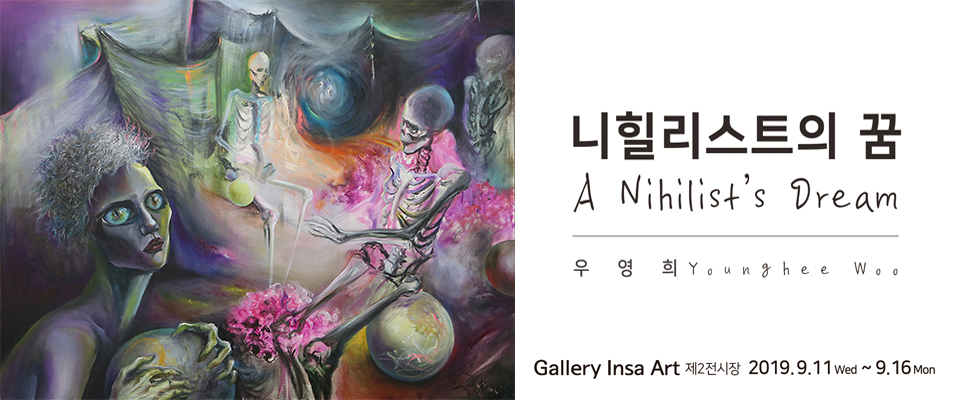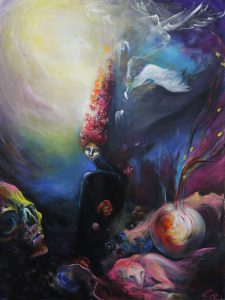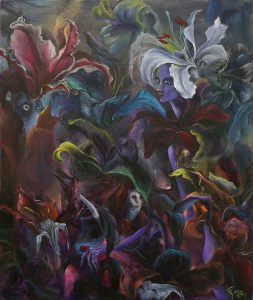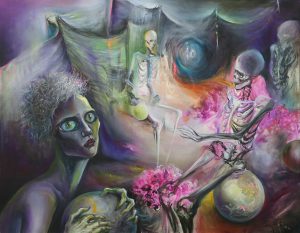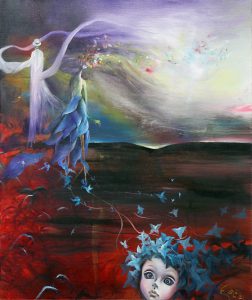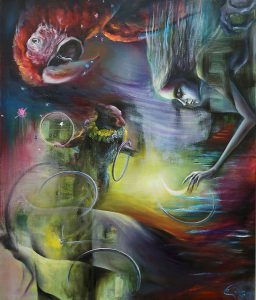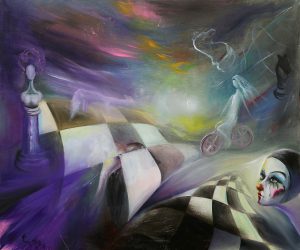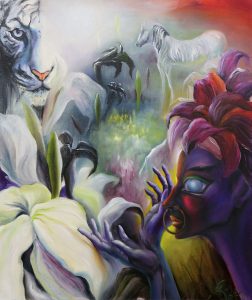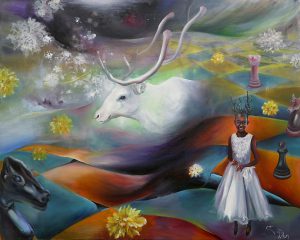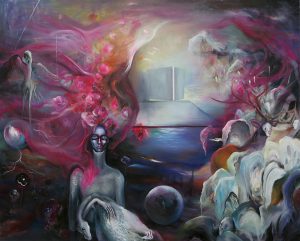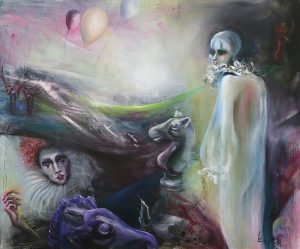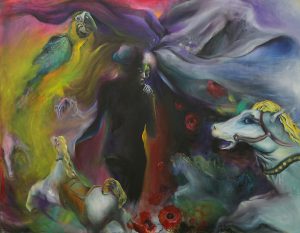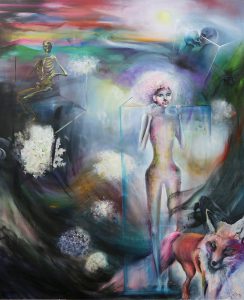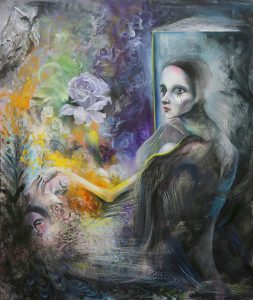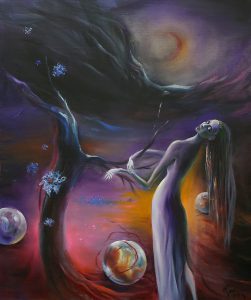우영희 개인전 니힐리스트의 꿈 A Nihilist’s Dream
우영희
2019 09/11 – 09/16
2 전시장 (2F)
8회 전시. 니힐리스트의 꿈 A Nihilist’s Dream
<작가의 글>
품었던 꿈들은 흘러 강물 되어야 하리.
화려하고 선명하게 기억되어 있던 정열은 타인의 보라빛 목소리로 절규하는 몽상가의 하얀 구두 위로 뚝뚝 떨어지는 역설 속에서 차라리 감사해야 할 것이다.
절정을 치닿는 유희의 파티는 끝나야 할 지점에서 멈추는 것이 당연하다.
The dreams that I yearned for will have to flow as river.
The vivid splendid ardor in memory, dissolving into the paradox drops falling on the white shoes of a dreamer with purple cry, must rather be grateful.
The playful celebration in climax must end where it should.
꿈과 환상, 그리고 그림
이선영(미술평론가)
화려하면서도 움울하고 자유로우면서도 강박적이며, 강렬하면서도 모호한 우영희의 작품은 환상과 현실의 밀접한 관계를 암시한다. 환상과 현실은 예술의 항구적인 속성이며, 실생활에서 이와 비견되는 대표적 체험으로는 꿈을 들 수 있다. 우영희의 작품은 꿈과 환상, 그리고 예술과의 밀접한 관계를 암시한다. 초현실주의자들에게 백일몽은 예술의 본질적 특징을 다르게 말한 것에 지나지 않는다. 현대미술의 결정적 국면에서 예술이라는 의식적 활동은 무의식을 중요한 자원으로 발굴하려 했다. 그냥 꿈이든 백일몽이든 간에, 모호한 시공간 속에서 불쑥불쑥 등장하는 인물과 사물이 만드는 단편적 의미들은 얼마나 황당하면서도 현실적인가. 그러나 비현실성이 모두 이상적인 것은 아니어서, 불행한 사람은 악몽같은 현실을 산다고 묘사된다. 문화산업은 이 무한대의 자원을 활용하기 위해 엄청난 노력을 해왔으며, 공상과학 영화에 나오는 것처럼, 뇌에 전극을 꽂아 원하는 꿈을 꾸게 하는 상품이 나올지도 모른다.
잘 때 빼고 인터페이스에서 눈을 떼지 않는 현실은 그러한 시점이 이미 와 있음을 예고한다. 오히려 그러한 기구들이 진짜 잘 수 있는 시간을 점점 더 빼앗는 것이 문제다. 수면으로 대변되는 꿈의 영역이 없다면 현실 생활은 위기에 빠진다. 그것은 경제적 이익을 제외한다면 환상의 쓸모와 기능이 의심되는 시대에 환상이 필요한 최소한의 ‘생물학적’ 이유가 될 것이다. 우영희의 작품에서 인물과 사물(동식물과 기구 등)이 나타나 뭔가 은유적으로 말하고 있지만, 시공간대가 특정되지 않은 화면은 꿈과 비교할만하다. 그림은 꿈처럼 현실에서 충족되지 못한 욕망이 풀려나는 공간이기도 하지만, 현실의 상징적 질서 또한 은유적이다. 정신분석학에서 은유적 어법은 ‘욕망의 수사학’(페터 비트머)이라고 정의된다. 페터 비트머는 라깡의 이론을 해설한 [욕망의 전복]에서, 은유적 차원은 주체로 하여금 자신의 동일성에 도달할 수 없게 하는 결핍을 항상 반복적으로 도입한다고 풀이한다.
욕망이 끝이 없는 만큼 환상도 그림도 끝이 없다. 화가는 보통사람들과는 달리 꿈의 희미한 이미지에 선명한 색감과 형태를 부여할 수 있다. 꿈이 강렬한 느낌만을 남긴 채 (무)의식의 저편으로 사라진다면, 예술작품이라는 또 다른 꿈은 최초의 강렬함을 현실화하기 위해 자신이 가진 모든 것을 동원하며, 그렇게 해서 꿈을 좀 더 안정적 형태로 제시한다. 작가란 이렇게 만들어진 제2의 현실을 통해 타자와 소통하는 자이다. 우영희의 환상적인 작품들은 직설 어법이 아닌 은유를 사용한다. 이러한 어법의 특징인 불확실성과 유동성은 보다 많은 의미를 담기 위한 방편이기도 하다. 캐스린 흄은 [환상과 미메시스]에서 환상은 꿈같은 과대망상이나 응축의 상태를 허용한다고 말한다. 흄은 과학적 언어로 대변되는 하나의 지시대상만을 나타내는 전문용어는 명백한 것을 지향하지만, 환상은 풍부함을 지향한다고 본다. 우영희의 작품에서는 은유적 인물과 사물들이 자리하는 공간도 환상적이다.
그 공간은 대개 바닥이 없거나 불안정하게 출렁거린다. 가령 작품 [끝내 사라지고 만 꿈]이나 [다시 만나고픈 꿈]에서 서양 장기판 무늬같은 기하학적인 선은 심하게 요동치면서 이면의 힘을 가시화한다. 시간대를 짐작하게 하는 빛은 더욱 모호하다. 작품 [한겨울에 맺은 꿈], [끝내 사라지고 만 꿈]처럼 화면에 등장하는 달 같은 자연적 광원을 빼면 작품 속 빛은 무대조명 같다. 초자연적인 화면에서 인공/자연광을 논하는 것 자체가 부조리하다. 초승달 모양은 낭만주의적 감수성을 나타내는 기표로 봐야 할 것이다. 고전주의가 계몽적 이성을 통해 낱낱이 비춰야 하는 세계는 자아의 관심사에 따라 자의적인 조명으로 비춰지는 세계이다. 화면 내부의 빛은 인물을 비추기보다는 추상적인 원근감을 부여한다. 추상적 원근감 속의 세계는 안인지 바깥인지도 구별할 수 없다. 그렇게 만들어진 공간 속에서 다양한 설정의 인물은 추락과 비상, 비틀거림과 유영을 거듭한다. 작품 [금기의 꿈]에서 괴물같은 심해어, 저글링 하는 서커스의 동물, 심연을 향하는 한 여자는 화면에서 모순 없이 공존한다.
기하학적 선은 이러한 색/빛의 물결 속에서 투명한 유리 감옥이나 어디론가 열 수 있는 문같이 보인다. 그것은 또한 이 자의식적 무대를 반영하는 거울이기도 해서, 화면 안팎의 인물은 거울을 보며 상상하고 때로 거울 저편으로 이동하기도 한다. 사빈 멜쉬오르 보네는 [거울의 역사]에서 거울을 통해서 보이는 세계를 넘어 보이지 않는 곳에 이를 수 있다는 사유를 소개한 바 있다. 그에 의하면 관측은 보이는 세계를 파악하는데, 이때 보이는 세계는 보이지 않는 세계와 닮은 것이다. 이를 통해 인간은 알려진 것에서 알지 못하는 것으로 올라간다. 이러한 사유에 의하면 볼 수 있는 것과 없는 것은 밀접하다. 시각성을 과학적으로 체계화한 르네상스 시대는 환상에 대해서도 그렇게 했다. [거울의 역사]에 의하면 알베르티와 레오나르도 다빈치는 거울이 닮음을 확인하고 인간의 눈을 가르치는 스승이라고 생각했지만, 동시에 환상을 만들어낸다는 것도 인정했다.
보네에 의하면 환상이란 닮음의 조작일 뿐이다. 환상이 만들어지면 그곳은 원래의 것보다 더 매력적이며 마찬가지로 단일성보다는 다양성이 매력적이다. 이렇게 해서 단 하나의 근원, 즉 모든 닮음의 근원에 대한 참조는 사라지고, 인간 정신을 흥분시키는 끝없이 많은 반사상의 다양한 변화가 그 자리를 대신한다는 것이다. 더 나아가 환상을 주려는 욕망 안에는 그와 반대되는 욕망, 즉 환상에 빠지려는 욕망 또한 스며든다고 본다. 우영희의 작품은 로즈마리 잭슨이 [환상성]에서 정의 한 바 있는 환상예술의 특징, 즉 ‘무질서와 무법을 향해, 법과 지배적 가치체계의 바깥에 놓여있는 것을 향해 열려있다’는 특징이 있다. 로즈마리 잭슨에게도 환상은 현실과 관련이 있다. 그에 의하면 ‘환상은 현실의 범주에 바탕을 두고 있으며 불가능, 비사실, 무명, 무정형, 미지, 비가시 등 19세기 리얼리즘의 범주에서는 오직 부정적인 용어로만 개념화할 수 있던 영역을 소개’한다고 지적한다.
[환상과 미메시스]의 저자 캐스린 흄에게 환상(fantasy)은 미메시스와 대조되는 개념이다. 어떤 류의 작가들은 현실의 모사를 넘어서 변화무쌍한 환상을 추구한다. 캐스린 흄은 미메시스와 댓구를 이루는 환상에서 ‘권태로부터의 탈출, 놀이, 환영, 결핍된 것에 대한 갈망, 독자의 언어습관을 깨뜨리고 주어진 것을 변화시키고 리얼리티를 바꾸려는 욕망’을 본다. 이러한 욕망은 자아의 분신이라 할만한 화면 속 인물들을 변신하게 한다. 화가에게 그림은 이러한 변신의 무대를 제공하기 때문에 중요하다. 그림은 마치 거울처럼 물리적으로 움직이지 않지만, 상상적으로는 부단히 움직인다. 주어진 공간을 넘어서려는 모험도 감행된다. [거울의 역사]는 거울의 제공하는 신비한 대칭이 일상적인 현실에 상응하는, 아니 그보다 더 나은, 보이지 않는 짝이 존재한다고 믿게 한다고 말한다. 거울을 넘어 반대쪽으로 가려는 꿈은 바로 다른 쪽에서 다시 태어나고 싶은 욕구에 부응한다는 것이다.
보네에 의하면 그것은 안과 밖을 조화시키려는 희망을, 그리고 현실의 무게와 죄의식의 압박을 벗어난 세계에서 결정적으로 환영과 상상 쪽에서 살아가려는 희망을 반짝거리게 한다. 그림/거울을 통해 신기한 나라로 여행을 시작하는 화가는 [거울나라의 앨리스]같은 모험을 한다. 보네는 거울 너머의 세계 즉 미지의 세계로의 이러한 도약에는 위험이 따른다고 경고한다. 그곳으로 가려면 다른 언어나 행동 양식이 요구되는 것이다. 우영희의 작품에도 알 수 없는 규칙에 따라 진행되는 장기게임에 던져지는 앨리스와 같은 캐릭터가 등장한다. 휘청이는 공간 으로 연출되곤 하는 장기판은 환상세계의 신비나 아늑함보다는 낯섦과 위험을 더 강조한다. 화면 저편으로 연결된 문같은 작품 [동녘의 꿈]에서 다른 차원으로 통하는 그 문을 열어젖힐 힘은 상상력이다. 꽃으로 된 머리는 상상의 세계로 빨려 들어가며 공중으로 흩어진다. 작품 [유리알 유희]에서 사각형 투명 감옥에 갇힌 여자는 다른 상자 안의 해골 신세를 벗어나지 못할 것이다.
거울같은 투명한 상자는 자아를 가두기도 하지만 어디론가 떠돌게 한다. 이러한 이동에서 명확한 방향타는 보이지 않는다. 이러한 표류는 자유보다는 불안감을 더 준다. 우영희의 작품에서 동물은 인간보다는 온전하고 자유롭다. 인간의 대부분의 불안 및 불행은 바로 자연으로부터 벗어났기 때문 아닌가. 눈물 흘리는, 또는 그러한 분장을 한 인물은 스스로 만든 덫에 자승자박 되는 상황을 표현한다. (꿈의) 무대같은 우영희의 작품에서 다양한 역할 연기를 하면서도 일관성을 가지는 캐릭터인 피에로는 적절한 화자(話者)이다. 작품 [끝내 사라지고 만 꿈]에서 장기판 무늬의 바닥이 요동치는 상황을 무대 밖의 관중에게고 알리는 이는 피에로다. 장기판의 말은 게임의 규칙을 벗어나 있다. 그러나 여전히 그것은 위반을 통해 규칙을 유지한다. 놀이에 관한 이론을 정립한 인류학자 로제 카유와는 규칙위반자보다 놀이의 장 자체가 몰수되는 것이 더 끔찍하다고 본다.
지배적 규칙과는 다른 규칙들로 놀이할 수 있는 장 자체가 사라진다면 그것은 어떤 악몽보다도 더 악몽일 것이다. 축제에서 집단적 카타르시스의 문을 여는 자, 즉 유쾌한 무질서를 야기하는 피에로같은 존재와 질서 잡힌 체계 속에서 항구적인 전쟁과 경쟁을 유도하는 이 중 누가 더 자유롭고 평화로운 세계를 위해 기여 하는가. 놀이의 장 속의 피에로는 소외의 상징은 아니다. 다만 환상 속에서도 현실은 반영되기에 슬픈 표정의 피에로는 있을 수 있다. 작품 [부메랑으로 돌아온 꿈]에서 하얀 의상을 입은 피에로는 장기의 말을 앞세우고 무대에 진입하며, 작품 [푸른 광대의 꿈]에서는 무대처럼 보이는 밝은 사각형 밖으로 나온다. 작품 [다시 만나고픈 꿈]에서 하얀 드레스를 입은 흑인 소녀나 작품 [고원에서 바라본 꿈]에서의 여자 마네킹은 꼭두각시같은 모습으로 피에로와 크게 다르지 않은 존재이다. 우영희의 작품에서 피에로는 다양한 역할로 변신할 수 있다는 점에서 자유롭지만, 동시에 그 무엇도 될 수 없다는 점에서 유령 같다. 피에로의 전형적인 표시인 색색의 마름모꼴 무늬 의상이 아닌 하얀 의상은 그러한 느낌을 강조한다.
다른 정체성이 되기 위해 자신의 정체성을 비우는 대표적인 캐릭터가 바로 피에로다. 예술가 또한 고정적 정체성을 가지지 않는다. 작가에게는 작품을 하고 있다는 정체성만 있을 따름이다. 예술가가 사회로부터 소외되기 시작했던 모더니즘 시기에 피에로는 거의 예술가의 초상같은 위상을 가졌다. 원래 피에로는 축제 때 왕이었다가 처형되는 캐릭터였다. 그러나 축제는 짧고 삶은 길며, 그래서 예술가/피에로는 고통받는다. 그렇지만 다시금 축제의 막이 열리길 기대한다. 피에로의 동료로는 인간보다는 동물이 더 잘 어울린다. 우영희의 작품에서 종적 특성이 명확한 화면 속 동물은 인간/피에로/예술가 보다 완전하고 안정적으로 보인다. 작품 [고원에서 바라본 꿈]에서 멋진 갈기털을 가진 늑대나 작품 [푸른 광대의 꿈]에서 무대 안팎의 인간적 사건들을 무심하게 바라보는 부엉이가 대표적이다. 물론 인간이 동물로 변신하는 순간은 위태롭다. 인간과 친숙한 가축인 말은 장기판의 말, 회전목마, 실제의 말 같은 이미지로 다양하게 나타난다. 말이라는 소재는 말처럼 달려나가거나 맴맴 도는 상상력, 무엇보다도 삶과 예술을 게임처럼 간주하면서 유희하는 매개로 활용된다.
식물은 자라고 피고 시드는 변신의 상징으로 나타나며, 작품 [9월의 꿈], [내 꿈을 들어보세요]처럼 인물의 머리 부근에 배치된다. 그것은 밀림처럼 자라나서 온 화면을 뒤덮으며 무엇이든 은신하고 나타날 수 있는 지형학이 된다. 식물은 자연에서 그렇듯이 동물과 함께 나타난다. 삶의 그림자인 죽음은 탄생부터 따라 다닌다. 작품 [화요일의 꿈]에서 관객을 응시하는 여자는 상상의 나래를 가득 피워 올리는데 가까이에 죽음(해골)이 함께한다. 환한 빛으로 상징되는 영감의 영역에 접근하기 위해 변신 중인 여자는 위험한 상태에 있다. 삶의 끝이 죽음이라면, 예술적 상상은 그 극단의 지점까지 뻗어 나가므로 모험적이고 위험하다. 작품 [25시의 꿈]에서 고양이 눈을 한 인물은 변신 중이며 근처의 해골들은 그 위험을 경고한다. 우영희의 작품 속 인물은 기괴하게 분장하거나 변신 중이지만 대개 여성이다. 자신의 또 다른 모습이 주인공인 환상의 무대에서 성(性)은 어떠한 역할을 할까.
페터 비트머는 [욕망의 전복]에서 라깡으로 대변되는 현대 정신분석학에서 남성성은 가시적인 것에 근거하며 이것을 기초로 논리적이고자 하는 속성을 가지고 있다면, 여성성은 논리를 벗어나는 것이며 파악이 불가능하며 가시적으로 나타나지도 않는 심연같은 것이라고 말한다. 그렇지만 여성은 실재에 대해 끊임없이 질문하게 되는 동인(動因)이다. 페터 비트머에 의하면 라깡은 남성성이 여성성 즉 구조지어지지 않은 것에 의해 구조 진다고 보았다. 라깡에게 여성은 말해질 수 없는 것이며 동시에 리비도의 원천이다. [욕망의 전복]에 의하면 라깡은 여성성을 하나의 실체로 파악하지 않는다. 여성성은 어떤 실체화도 벗어나는 범주라고 말했다. 여성은 지배적인 상징계로 남성만큼 수월하게 진입하지 못하고 상상계에 머물면서 상징계와 상호작용한다. 라깡의 영향을 받은 뤼스 이리가라이는 [근원적 열정]에서 상상계는 상징계의 이론적 구성보다 좀 더 단순하고 근원적이어서 삶과 죽음, 혈연관계, 몸과 같이 직접적인 체험과 관련된다고 본다.
이리가라이를 비롯한 여성 저자들은 여성과 남성의 자아 형성의 차이에 주목한다. 현대 정신분석학은 소년이 자신을 남근적 권력과 동일시함으로서, 상상의 단계에서 해방되어 상징적 질서로 진입하지만, 소녀는 이러한 과정에 어려움을 겪는다. 그것은 ‘주체성과 성이 이러한 상징계의 생산물’(라깡)이기 때문에 단순히 예술적 표현을 넘어서는 문제이다. 뤼스 이리가이나 줄리아 크리스테바를 비롯한 저자들은 여성은 왜 상징계에 온전히 진입하고 안착할 수 없는 것일까를 물어왔다. 그들은 여성 작가들의 작품에서 상상계/상징계가 명확하게 구별되지 않는 환상성을 본다. 상징계에 군림하는 남근이라는 기표–‘팰러스는 가부장적 질서의 지배와 아버지의 법을 의미한다’(라깡)–에 대한 회피가 여성으로 하여금 환상의 영역에 머무는 것을 자연스럽게 한다는 것이다. 하지만 환상은 때로 사회의 지배적인 상징계에 균열을 가하면서 지각변동을 일으킨다. 우영희의 작품에서 환상은 질풍노도같은 양상을 띄면서 표층적 질서에 도전한다.
Dream, fantasy, and paintings
– Sunyoung Lee
Flashy and dreary, free and compulsive, intense and ambiguous paintings of Younghee Woo imply the intimate relation between fantasy and reality. Fantasy and reality is a perpetual attribute of art, and the classic example in real life that can be comparable with this is a dream. Younghee Woo’s paintings suggests that dreams, fantasy, and art are closely connected. To surrealists, daydreams are noting other than essential qualities of art. In the crucial face of modern art, the conscious ritual called art tried to excavate an important resource, the unconsciousness. Either a nightdream or a daydream, how absurd and practical are these fragmentary meanings formed by characters and objects that protrude from vague space and time. However, unreality isn’t always ideal, so unfortunate people are often described as living a nightmare. The cultural industry has put a great deal of effort into utilizing this endless resource, and one day we might be able to connect electrodes to our brain and dream whatever we want, like SF movies.
The fact that we have our eyes glued on all kinds of interfaces except during sleep tells us that day has almost come. It is a problem that those equipments take away the actual sleep from us. Real life is in jeopardy if there is no realm of dream represented by sleep. It will be the minimum ‘biological’ reason that fantasy is needed, in this world where the necessity of fantasy is suspected if not financially profitable. The characters(people) and objects(animals, plants, vehicles, etc) are speaking metaphorically in Woo’s works, but the background with uncertain time and space is comparable with dream. The paintings are the place where the ungratified desires from reality are let out, like dreams, but the symbolic order of reality is also metaphoric. Metaphor is often defined as ‘the Rhetoric of Desire’(Peter Widmer) in psychoanalysis. Peter Widmer in [Subversion of Desire], explaining Jacques Lacan’s theory, says metaphoric level repeatedly brings in the deficiency that makes it impossible for a subject to reach its identity.
As endless is the desire, so is fantasy and art. Artists, unlike other people, can give forms and colors to the blurry image of dream. If a dream disappears beyond consciousness leaving just an impression, another dream called artwork uses every possible means to actualize the initial impression, thus creating a much more stable form of dream. Artists are the ones who communicate with others through this secundus reality. Woo’s mesmerizing works use allegories instead of indicative mood. To use this type of speech, that has uncertainty and flexibility, is one way of including much more meanings. Kathryn Hume in [Fantasy and Mimesis] says fantasy allows delusions of grandeur or condensation like dreams. Hume says technical term, represented by scientific language, that has one referent aims for clearness, when fantasy seeks abundance. In Younghee Woo’s works, the space where metaphoric characters and objects are located is dereistic as well.
The spaces are usually floorless or astatically sloshing. For example, in the works [The dream that vanished eventually] and [Dream, hope to see again] the check-board patterned geometric lines are extremely waving, visualizing the force beyond. The light that lets us assume the time is even more equivocal. They seem like stage lightings except for the moonlike natural light source that appears in the works [Midwinter Dream] and [The dream that vanished eventually]. Mentioning about artificial or natural lights itself is irrational, since the screen is supernatural. We will have to accept the crescent moon as a signifier of romantic sensitivity. The world where classicism must illuminate through enlightening reason is the world where arbitrary lightings shine depending on self interests. The lights in the screen gives abstract perspective to the paintings, rather than lighting up the characters. In the world of abstract perspective, you can not tell wether it’s inside or outside. The characters in various settings repeat falling, soaring, stumbling, and swimming in such formed spaces. In the work [Taboo Dream], the monstrous deep-sea fish, the juggling animal from circus, and the woman walking towards an abyss coexist without contradiction.
In the waves of colors and lights, the geometric lines look like a clear glass jail, or a door to another world. It is also a mirror that reflects the sense of identity, making people in and out of the screen imagine or move beyond the mirror, looking into it. Sabine Melchior-Bonnet introduced her thoughts on mirror through which we can reach the invisible. According to her, observation lets us understand the visible world, and this visible world resembles the invisible world. And through this, human beings ascend from known to unknown. This shows high affinity between the visible and the invisible. During the Renaissance, visibility was scientifically systematized and so was fantasy. It is written in [The Mirror : A History] that Leon Battista Alberti and Leonardo Da Vinci thought that mirror was an optical device that guides human eyes, but also admitted that it creates fantasy-illusions-.
According to Bonnet, fantasy is nothing but a distortion of resemblance. A fantasy is apt to be more attractive than the original, and likewise, variety overwhelms unity. Eventually the reference to the original will be gone, and the variations or endless reflection that excites human mentality will replace it. Furthermore, she sees that beneath the desire to give fantasy pervades the opposite, the desire to indulge in the fantasy. Younghee Woo’s works have a characteristic of fantastic art that Rosemary Jackson defined in [Fantasy], that ‘it opens up on to disorder, on to illegality, on to that which lies outside the law, that which is outside doinant value systems.’ Even to Rosemary Jackson, fantasy is relevant to reality. She points out that ‘fantasy is based on reality, and it introduces the realm which was only conceptualized by negative terms in nineteenth century such as impossibility, nonfact, obscurity, amorphousness, unknown, and invisible.’
To Kathryn Hume, the author of [Fantasy and Mimesis], fantasy is contrasting concept with mimesis. Some artists pursue protean fantasy over replication of reality. Hume sees ‘escape from fatigue, amusement, illusion, longing for the lack, and the desire to break readers’ linguistic habits change givens and alter reality’ from fantasy that form an antithesis to mimesis. These desires make the characters that can be called alter egos transformed. Paintings are important for artists because they provide the arena of this transformation. Paintings do not move physically like mirrors, but they do constantly in imagination. They even venture to go beyond the given space. [The Mirror : A History] says the mysterious symmetry given by a mirror makes us believe the existence of a reality-corresponding, or even better invisible pair. The dream to go to the other side of the mirror meets the desire to be born again on the other side.
Bonnet says that this lights up the hope to harmonize the inside and outside, to live in a world free of guilt and weight of reality, the world of phantasm and imagination. An artist setting off on a trip to the mysterious land through painting/mirror has an adventure like [Alice Through the Looking Glass]. Bonnet warns of the danger that follows the leap to the unknown, the world beyond the mirror. A totally different language or behavior pattern is required to be there. There also is a character like Alice who is thrown in a chess-like game played by the rules we can not know. The check board as a staggering stage emphasizes unfamiliarity and hazard rather than mystery and snugness of fantasty world. The work [Eastern Dream] looks as if it is a door to another dimension, and it is the power of imagination that can open the door. The flower-made head is sucked into the imaginary world and dissolved into the air. The woman imprisoned in the trasparent cubicle in the work [Das Glasperlenspiel] will probably end up becoming a skeleton in another box.
The mirror-like transparent box not only cages self but also makes one wander about. It is hard to tell in which direction the movement is made, and this kind of drift creates anxiousness rather than freedom. In Woo’s works, animals seem more secure and liberated than human beings. Isn’t the human apprehensions and unhappiness coming from the fact that we are off the nature? The character shedding tears shows that she is hoisted with her own petard. The clown, the character that performs various roles and yet still has consistency in Woo’s works, is a proper narrator. In the work [The dream that vanished eventually], it is the clown who notifies the audience outside the stage that the check board floor is convulsing. The markers on the check board are against the rules. But the rules are kept by violations. Roger Caillois who formulated play theory considers the collapse of the field of play a bigger tragedy than the rule breakers.
It will be the most devastating nightmare ever if the field to play with any other rules than predominant one disappears. Who contributes to the world more peaceful and free, the one who opens the door of collective catharsis in a festival, like a clown that causes joyful chaos, or the one who drives competition and everlasting war in the orderly system? The clown in the field of play is not the symbol of alienation. However, there can be a clown with the grieved look because even the world of fantasy reflects reality. In the work [Dream Boomerang], a clown with white costume enters the stage with a marker in chess, and it comes out to bright square that looks like a stage in the work [Cyanic Clown’s Dream]. A female mannequin that looks like a puppet in the work [Dream from the Plateau] or the little African girl wearing a white dress in the work of [Dream, hope to see again] are not much different with a clown. In Woo YoungHee’s work, a clown is free in a way that it can play various roles, but at the same time ghostly, because it can never actually be anything. The white costume which is not a typical clown’s signature lozenge pattern emphasizes it. The typical character that empty one’s identity in order to be something else is a clown. Artists also have flexible identity. The only definable identity to artist is the work of art. In the age of modernism where artist started being left out by the society, clowns had almost the same position as the portrait of an artist. A clown was the character that gets executed after being the king of a festival. However, life is long and festival is short, therefore, artists/clowns suffer. But expectations are on for the curtain to be risen with the festival.
Animals fit better than human to be an associate with clowns. Animals of certain species seem more stable and complete than humans/clowns/artists in Woo’s paintings. The wolf with fabulous mane from the work [Dream from the Plateau] or the owl that stares at human incidents in and out of the stage indifferently from the work [Cyanic Clown’s Dream] are the prime examples. The moment where human transits into animals sure are precarious. The horse, a close livestock for human, appears in various images such as a marker horse in chessboard, a part of carousel, an actual appearance of horse and many others. A material called horse is practically used as an intermediation that puts on a spurt, chirps with imagination, and regards life and art as a game and enjoys. Plants appear as symbols of transformation of growth, blooming, and withering. They are allocated near the head of the characters as in the work [September’s Dream] and [Here is my dream]. They grow like a jungle that covers all over the surface and becomes geomorphology that anything can hide and show. Plants appear with animals like it does in the nature. Death, the shadow of life, follows it from the beginning. In the work [Tuesday’s Dream], death(skeleton) follows in nearby as a woman gazes into the audience lost in imagination. The woman who is transforming to approach the realm of inspiration represented by bright light is now in danger. If the end of life is death, artistic imagination stretches out to the extreme point, hence adventurous and dangerous. In the work [25:00’s Dream] the character with cat eyes is in the process of transition and the skulls nearby try to warn the danger. The characters in the work of Younghee Woo are wearing grotesque make-up or transforming, but are usually women. In the stage of fantasy where another figure of oneself is the main character, what role would sex(gender) play?
In [Subversion of Desire], Peter Widmer says that in modern psychoanalysis represented by Lacan, masculinity is on the basis of what is visible and has an attribute to be logical, while femininity is beyond logic, impossible to grasp, invisible and abyssal. However, females are the motive for incessant questions on existence. According to Widmer, Lacan thought masculinity was structured by femininity, which is not so structured. To Lacan, females are something indefinable and at the same time, the source of libido. In [Subversion of Desire], Lacan does not understand femininity as a substance. He said femininity is beyond any substancial category. Females do not enter as easily to the dominant Symbolic as males, they hover in Imaginary, interacting with symbolic. Luce Irigaray who was influenced by Lacan describes in [Elemental Passions] that Imaginary is more simple and primary than the logical structure of Symbolic, so it is related to direct experiences such as life and death, kinship, and body.
Women authors including Irigaray focus on the different self formation of female and male. In modern psychoanalysis describes that a boy identifies himself with phallic power to liberate himself from imaginary level and enter symbolic order, but a girl has difficulty in the process. It is the matter beyond simple artistic articulation because ‘identity and sex is the product of this Symbolic.’(Lacan) Women authors including Luce Irigaray and Julia Kristeva have asked why females can not enter and settle in Symbolic entirely. They see the fantasy which Imaginary and Symbolic are not clearly distinguished from women artists’ works. The avoidance of phallus, the reigning signifier in Symbolic-‘Phallus stands for male-dominated society and patriarchal law(Lacan)’- makes it natural for females to stay in the realm of fantasy. But from time to time, fantasy gives crack to the dominant Symbolic and reshapes society. Younghee Woo challenges the superficial order with the tempestuous fantasy in her work.
